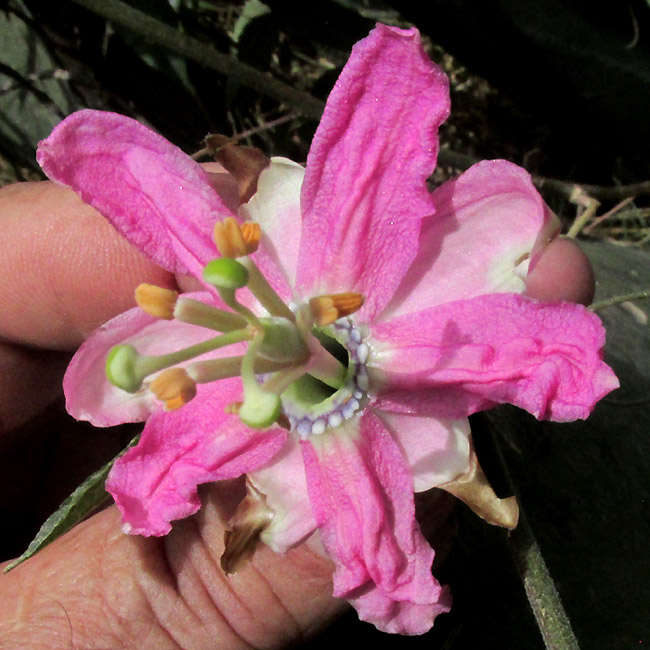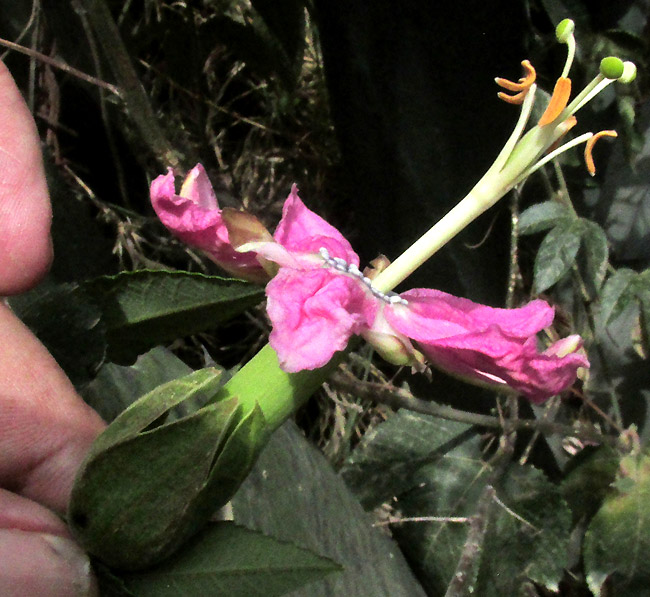Excerpts from Jim Conrad's
Naturalist Newsletter
Entry from field notes dated June 30, 2023, from small gravel road entering El Suspiro from El Socavón, about 1 straight-line km NW of El Doctor; in the mountains of east-central Querétaro state, municipality of Cadereyta de Montes, 12 straight-line kms due east of Vizarrón de Montes but much farther by twisting roads; elevation ~2560m (~8400 ft), Querétaro, MÉXICO, (N20.85526°, W99.58356°)
BANANA PASSIONFLOWER/ PASSIONFRUIT

Beside the road, entangled among a mague agave's big, spine-tipped, leaves, a semi-woody vine bore the pretty flower shown above. With the blossom's size, five brightly colored petals alternating with colorful sepals, and with the remarkable arrangement of sexual parts emerging from the flower's center, it couldn't have been anything but a passionflower of the passionflower genus Passiflora, of the Passionflower Family, the Passifloraceae. The sexual parts' unique arrangement are better observed from the side:

The straight, white thing emerging from the corolla's center is a cylinder formed from the fused filaments of five stamens. Toward the picture's top, right corner the cylinder branches into five parts, atop which orangish, pollen-producing anthers are affixed. Within the bouquet of anthers, there's a barely visible light green, oval shaped item, the ovary, atop which three stalked, green stigmas arise. The flower itself emerges from within five green bracts forming something like a cup.
Currently about 550 species of Passiflora are recognized, the vast majority native to the Americas. Many species bear small, easily overlooked flowers such as Passiflora obovata. Others are much more decorative, such as those shown lower down our page for the much grown, edible Passion Fruit, Passiflora edulis.

This vines flowers, however, were missing a feature that on the overwhelming majority of species is very conspicuous: the corona filaments. In the flower pictures on the edible Passion Fruit page, the corona filaments are the hairlike features radiating from below the ovary. On our flower, the corona is reduced to white stubs encircling the blossom's mouth, as shown at the right.

The vine's leaf was large and deeply three-parted, its undersurface much paler than its top surface, and hairless. You can see how stiff and straight the vine's lower, semi-woody stems grow.
This isn't a native species, nor does it seem to have escaped into the landscape. Despite its occurrence along a road, here it appears to be strictly a cultivated species. Several homes in El Suspiro had the vine climbing up in backyard trees, though I saw no indications of efforts to manage them. I saw a few oblong, yellow fruits dangling from the vines, but they were too far away to photograph.
With such large, pink flowers, the notable absence of corona filaments and the hunch that this was a cultivated species, it was easy to identify by doing an Internet image search on the keywords "passiflora edible pink." Flowers matching ours were labeled PASSIFLORA TARMINIANA. In English usually it's called Banana Passionfruit because its dangling fruits are yellow and somewhat thickly banana shaped, though not curved. Sometimes English-speaking gardeners call it by names used in the species' native area of southern Mexico to Venezuela and Peru, such as curuba, curuba de Castilla, tumbo and tumbo serrano.
Images of Passiflora tarminiana show flowers with varying features, largely because there's been much confusion about its technical name. Earlier it was lumped into Passiflora mollissima, sometimes known as Passiflora tripartida var. mollissima. Also, as reported in the 2012 work by T. Ocampo and O.C. Quintero entitled "Manual para el cultivo de frutales en el trópico," owing to hybridization, undefined ecotypes exit -- forms occurring only locally. A feature distinguishing our Passiflora tarminiana from other similar taxa is that its corollas open widely, instead of drooping from the dangling flower. Also, the large, greenish bracts at the flowers' bases are larger and the stamen tube longer than in similar taxa.
Is this a passionflower or a passionfruit vine? It depends on one's orientation, since neither name has taxonomic value. In South America it's mainly planted as a commercial food crop, but in California probably it's planted as much for its pretty flowers as for the fruits. In Hawaii and New Zealand it's considered an invasive species.
Though it's frequently cultivated in some countries, numerous experts say that its potential is much greater than how it's being used. Nutritionally its fruits are exceptionally high in antioxidants and vitamins, and compounds in its leaves have been shown to reduce anxiety. Traditionally the fruit has been used medicinally to treat ulcers, gastritis and other stomach problems.
As a food, the fruit is eaten raw, made into a mousse (egg whites or whipped cream in cold milk and sugar, whipped to add tiny air bubbles), juice is produced, and ice cream, jellies, marmalade and more are made of it. It goes into fruit salads. On an industrial scale concentrates from it and its pulp are used.